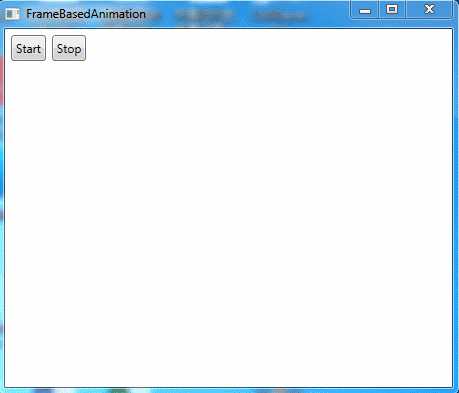【WPF学习】第五十六章 基于帧的动画
2021-03-15 09:29
标签:starting 动画 can text 配置 method height 获得 dom 除基于属性的动画系统外,WPF提供了一种创建基于帧的动画的方法,这种方法只使用代码。需要做的全部工作是响应静态的CompositionTarge.Rendering事件,触发该事件是为了给每帧获取内容。这是一种非常低级的方法,除非使用标准的基于属性的动画模型不能满足需要(例如,构建简单的侧边滚动游戏、创建基于物理的动画式构建粒子效果模型(如火焰、雪花以及气泡)),否则不会希望使用这种方法。 构建基于帧的动画的基本技术很容易。只需要为静态的CompositionTarget.Rendering事件关联事件处理程序。一旦关联事件处理程序,WPF就开始不断地调用这个事件处理程序(只要渲染代码的执行速度足够快,WPF每秒将调用60次)。在渲染事件处理程序中,需要在窗口中相应地创建或调整元素。换句话说,需要自行管理全部工作。当动画结束时,分离事件处理程序。 下图显示了一个简单示例。在此,随机数量的圆从Canvas面板的顶部向底部下落。它们(根据随机生成的开始速度)以不同速度下降,但一相同的速率加速。当所有的圆到达底部时,动画结束。 在这个示例中,每个下落的圆由Ellipse元素表示。使用自定义的EllipseInfo类保存椭圆的引用,并跟踪对于物理模型而言十分重要的一些细节。在这个示例中,只有如下信息很重要——椭圆沿X轴的移动速度(可很容易地扩张这个类,使其包含沿着Y轴运动的速度、额外的加速信息等)。 应用程序使用集合跟踪每个椭圆的EllipseInfo对象。还有几个窗口级别的字段,它们记录计算椭圆下落时使用的各种细节。可很容易地使这些细节变成可配置的。 当单击其中某个按钮时,清空集合,并将事件处理程序关联到CompositionTarget.Rendering事件: 如果椭圆不存在,渲染代码会自动创建它们。渲染代码创建随机数量的椭圆(当前为20到100个),并使他们具有相同的尺寸和颜色。椭圆被放在Canvas面板的顶部,但他们沿着X轴随机移动: 如果椭圆已经存在,代码处理更有趣的工作,以便进行动态显示。使用Canvas.SetTop()方法缓慢移动每个椭圆。移动距离取决于指定的速度。 为提高性能,一旦椭圆到达Canvas面板的底部,就从跟踪集合中删除椭圆。这样,就不需要再处理它们。当遍历集合时,为了能够工作而不会导致丢失位置,需要向后迭代,从集合的末尾向起始位置迭代。 如果椭圆尚未到达Canvas面板的底部,代码会提高速度(此外,为获得磁铁吸引效果,还可以根据椭圆与Canvas面板底部的距离来设置速度): 最后,如果所有椭圆都已从集合中删除,就移除事件处理程序,然后结束动画: 示例完整XAML标记如下所示: 显然,可扩展的这个动画以使圆跳跃和分散等。使用的技术是相同的——只需要使用更复杂的公式计算速度。 当构建基于帧的动画时需要注意如下问题:它们不依赖与时间。换句话说,动画可能在性能好的计算机上运动更快,因为帧率会增加,会更频繁地调用CompositionTarget.Rendering事件。为补偿这种效果,需要编写考虑当前时间的代码。 开始学习基于帧的动画的最好方式是查看WPF SDK提供的每一帧动画都非常详细的示例。该例演示了几种粒子系统效果,并且使用自定义的TimeTracker类实现了依赖与时间的基于帧的动画。 【WPF学习】第五十六章 基于帧的动画 标签:starting 动画 can text 配置 method height 获得 dom 原文地址:https://www.cnblogs.com/Peter-Luo/p/12431549.html
public class EllipseInfo
{
public Ellipse Ellipse
{
get;
set;
}
public double VelocityY
{
get;
set;
}
public EllipseInfo(Ellipse ellipse, double velocityY)
{
VelocityY = velocityY;
Ellipse = ellipse;
}
}
private List
private bool rendering = false;
private void cmdStart_Clicked(object sender, RoutedEventArgs e)
{
if (!rendering)
{
ellipses.Clear();
canvas.Children.Clear();
CompositionTarget.Rendering += RenderFrame;
rendering = true;
}
}
private void cmdStop_Clicked(object sender, RoutedEventArgs e)
{
StopRendering();
}
private void StopRendering()
{
CompositionTarget.Rendering -= RenderFrame;
rendering = false;
}
private void RenderFrame(object sender, EventArgs e)
{
if (ellipses.Count == 0)
{
// Animation just started. Create the ellipses.
int halfCanvasWidth = (int)canvas.ActualWidth / 2;
Random rand = new Random();
int ellipseCount = rand.Next(minEllipses, maxEllipses + 1);
for (int i = 0; i )
{
Ellipse ellipse = new Ellipse();
ellipse.Fill = Brushes.LimeGreen;
ellipse.Width = ellipseRadius;
ellipse.Height = ellipseRadius;
Canvas.SetLeft(ellipse, halfCanvasWidth + rand.Next(-halfCanvasWidth, halfCanvasWidth));
Canvas.SetTop(ellipse, 0);
canvas.Children.Add(ellipse);
EllipseInfo info = new EllipseInfo(ellipse, speedRatio * rand.Next(minStartingSpeed, maxStartingSpeed));
ellipses.Add(info);
}
}
}
else
{
for (int i = ellipses.Count - 1; i >= 0; i--)
{
EllipseInfo info = ellipses[i];
double top = Canvas.GetTop(info.Ellipse);
Canvas.SetTop(info.Ellipse, top + 1 * info.VelocityY);
}
if (top >= (canvas.ActualHeight - ellipseRadius * 2 - 10))
{
// This circle has reached the bottom.
// Stop animating it.
ellipses.Remove(info);
}
else
{
// Increase the velocity.
info.VelocityY += accelerationY;
}
if (ellipses.Count == 0)
{
// End the animation.
// There‘s no reason to keep calling this method
// if it has no work to do.
StopRendering();
}


Window x:Class="Animation.FrameBasedAnimation"
xmlns="http://schemas.microsoft.com/winfx/2006/xaml/presentation"
xmlns:x="http://schemas.microsoft.com/winfx/2006/xaml"
Title="FrameBasedAnimation" Height="396" Width="463.2">
Grid Margin="3">
Grid.RowDefinitions>
RowDefinition Height="Auto">RowDefinition>
RowDefinition>RowDefinition>
Grid.RowDefinitions>
StackPanel Orientation="Horizontal">
Button Margin="3" Padding="3" Click="cmdStart_Clicked">StartButton>
Button Margin="3" Padding="3" Click="cmdStop_Clicked">StopButton>
StackPanel>
Canvas Name="canvas" Grid.Row="1" Margin="3">Canvas>
Grid>
Window>


using System;
using System.Collections.Generic;
using System.Linq;
using System.Text;
using System.Threading.Tasks;
using System.Windows;
using System.Windows.Controls;
using System.Windows.Data;
using System.Windows.Documents;
using System.Windows.Input;
using System.Windows.Media;
using System.Windows.Media.Imaging;
using System.Windows.Shapes;
namespace Animation
{
/// summary>
/// FrameBasedAnimation.xaml 的交互逻辑
/// summary>
public partial class FrameBasedAnimation : Window
{
public FrameBasedAnimation()
{
InitializeComponent();
}
private bool rendering = false;
private void cmdStart_Clicked(object sender, RoutedEventArgs e)
{
if (!rendering)
{
ellipses.Clear();
canvas.Children.Clear();
CompositionTarget.Rendering += RenderFrame;
rendering = true;
}
}
private void cmdStop_Clicked(object sender, RoutedEventArgs e)
{
StopRendering();
}
private void StopRendering()
{
CompositionTarget.Rendering -= RenderFrame;
rendering = false;
}
private ListEllipseInfo> ellipses = new ListEllipseInfo>();
private double accelerationY = 0.1;
private int minStartingSpeed = 1;
private int maxStartingSpeed = 50;
private double speedRatio = 0.1;
private int minEllipses = 20;
private int maxEllipses = 100;
private int ellipseRadius = 10;
private void RenderFrame(object sender, EventArgs e)
{
if (ellipses.Count == 0)
{
// Animation just started. Create the ellipses.
int halfCanvasWidth = (int)canvas.ActualWidth / 2;
Random rand = new Random();
int ellipseCount = rand.Next(minEllipses, maxEllipses + 1);
for (int i = 0; i ellipseCount; i++)
{
Ellipse ellipse = new Ellipse();
ellipse.Fill = Brushes.LimeGreen;
ellipse.Width = ellipseRadius;
ellipse.Height = ellipseRadius;
Canvas.SetLeft(ellipse, halfCanvasWidth + rand.Next(-halfCanvasWidth, halfCanvasWidth));
Canvas.SetTop(ellipse, 0);
canvas.Children.Add(ellipse);
EllipseInfo info = new EllipseInfo(ellipse, speedRatio * rand.Next(minStartingSpeed, maxStartingSpeed));
ellipses.Add(info);
}
}
else
{
for (int i = ellipses.Count - 1; i >= 0; i--)
{
EllipseInfo info = ellipses[i];
double top = Canvas.GetTop(info.Ellipse);
Canvas.SetTop(info.Ellipse, top + 1 * info.VelocityY);
if (top >= (canvas.ActualHeight - ellipseRadius * 2 - 10))
{
// This circle has reached the bottom.
// Stop animating it.
ellipses.Remove(info);
}
else
{
// Increase the velocity.
info.VelocityY += accelerationY;
}
if (ellipses.Count == 0)
{
// End the animation.
// There‘s no reason to keep calling this method
// if it has no work to do.
StopRendering();
}
}
}
}
}
public class EllipseInfo
{
public Ellipse Ellipse
{
get;
set;
}
public double VelocityY
{
get;
set;
}
public EllipseInfo(Ellipse ellipse, double velocityY)
{
VelocityY = velocityY;
Ellipse = ellipse;
}
}
}
上一篇:C#编码规范
下一篇:C# TTS-文本转语音